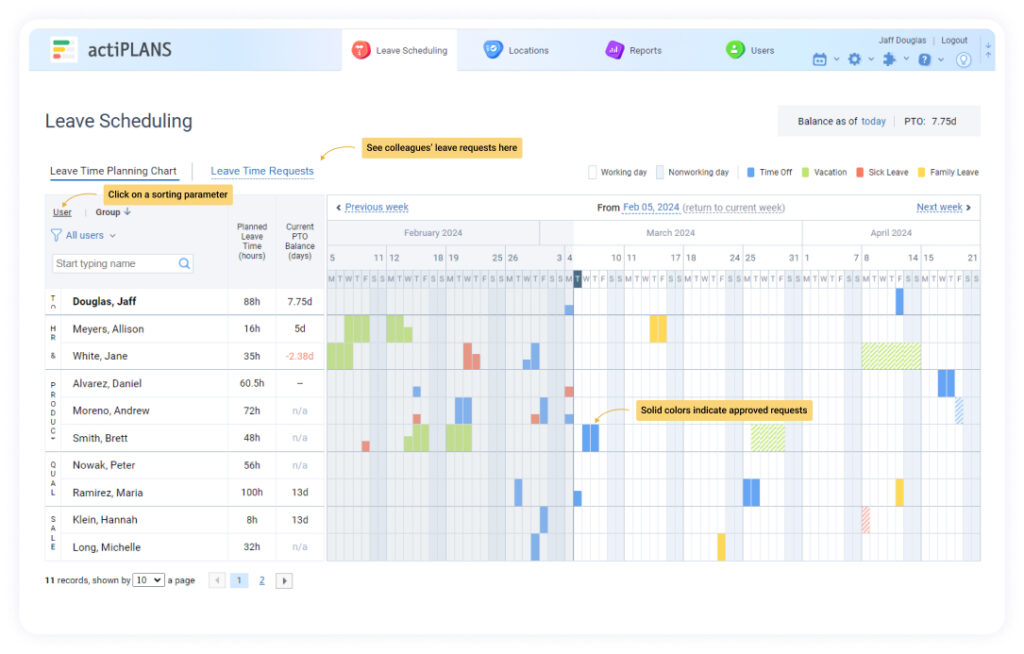As working mothers continue to make important strides in the workplace, it’s more important than ever to provide them with a work environment that is both understanding and supportive.
By creating equitable maternity leave policies, you can establish an effective culture of care for your female employees – resulting in a happier, healthier workforce and competitive advantages for your business.
Here, we’ll explore the best practices surrounding maternity leave in order to help you ensure a positive experience for all those involved.
What Is Maternity Leave?
Maternity leave is a period of absence from work granted to women who are pregnant or have just given birth. The purpose of maternity leave is to allow new mothers to recover from childbirth and bond with their newborn child. The duration of maternity leave varies depending on the country and the employer, but it usually ranges from a few weeks to several months.
Benefits of Maternity Leave
In summary, the benefits of maternity leave extend beyond just the well-being of the mother and child. Employers who offer maternity leave can also experience positive outcomes, such as improved employee retention, increased productivity, and a better employer brand.
- According to a study by the National Partnership for Women & Families, businesses that offer paid family leave experience lower turnover rates and save on the costs of recruiting and training new employees.
- Moreover, a study by the Center for Economic and Policy Research found that women who took maternity leave were more likely to return to work, and their wages increased in the long term.
- Similarly, this data indicates that companies with family-friendly policies, including paid parental leave, had better productivity and profitability than those that did not offer such policies.
Furthermore, offering maternity leave can also improve a company’s reputation and employer brand, as it demonstrates a commitment to supporting employees’ well-being and work-life balance. This can help attract and retain top talent, as well as enhance the company’s overall culture and employee satisfaction.
Rules and Regulations for Maternity Leave: United States
In the United States, there is no federal law mandating paid maternity leave, and it is up to individual employers to decide whether or not to provide it. However, the Family and Medical Leave Act (FMLA) provides eligible employees with up to 12 weeks of unpaid leave for the birth or adoption of a child.
On top of that, the rules and regulations for maternity leave vary greatly depending on the state. For example, paid maternity leave is guaranteed by law in the following parts of the country:
- In Washington, the Paid Family Medical Leave Program (PFML) enables eligible employees to receive financial compensation for up to 12 weeks for both maternity and paternity leave. They are entitled to receive a percentage of their average wages earned in the qualifying period, subject to a maximum benefit of $1,000 per week. Additionally, employees can opt to take intermittent leave, allowing them to take leave in smaller time increments.
- California has Paid Family Leave (PFL), a state-run program that lets workers take time off work to care for a seriously ill family member (child, parent, spouse, or registered domestic partner) or to bond with a new child. The program guarantees up to 8 weeks of paid benefits in a 12-month period and allows employees to receive 60-70% of their weekly wages while they’re on leave.
- In New York, the Paid Family Leave program provides employees with job-protected, paid leave to care for a new child, support a family member with a serious health condition, or relieve family pressures when a family member is called to active military service. It covers most private sector employees in New York, regardless of the size of their employer, as well as some public sector employees. As of 2021, eligible employees can take up to 12 weeks of paid leave and receive up to 67% of their average weekly wage.
- In Colorado, the Paid Family and Medical Leave Insurance (FAMLI) program will introduce a new maternity leave benefit starting on January 1, 2024. Eligible workers will be able to take maternity leave in a range of different ways: as a continuous leave, intermittent leave, or reduced work schedule. In terms of the actual leave entitlement, workers will be able to take up to 12 weeks of paid time off. Besides, they may also be eligible for an additional 4 weeks of paid leave for childbirth complications.
- As of January 1, 2026, Delaware will implement a full-fledged paid leave program, which will provide time off to eligible employees to attend to their personal or family health needs, including sick leave, maternity/paternity leave, and disability leave. Under this law, private employers with at least 25 employees will be required to provide their staff members with up to 12 weeks of paid maternity/paternity leave per year in order to care for a new child + up to 6 weeks of regular paid sick leave every two years. Companies with 10-24 team members will be required to provide employees with parental leave alone, while smaller companies will be exempt from these obligations.
Maternity Leave Laws in Other Countries
- In the United Kingdom, all employees are entitled to up to 39 weeks of paid maternity leave with statutory maternity pay that equals 90% of their average weekly earnings for the first six weeks, followed by £151.20 per week or 90% of their average weekly earnings (whichever is lower) after that.
- In the European Union, the 1992 Pregnant Workers Directive mandates that employers must provide female workers with a minimum of 14 weeks of maternity leave. This duration includes 2 weeks of compulsory leave that must be taken before or after childbirth. The directive applies to all female employees, regardless of the length of their service, contract type, or working hours.
- In Australia, employees are entitled to up to 20 weeks of parental leave that is paid at the national minimum wage level. The leave is granted to eligible employees who need to care for a newly born or adopted child.
- In Russia, women are entitled to 140 days of paid maternity leave: 70 days of prenatal leave and 70 days of postnatal leave. The statutory maternity leave pay equals 100% of employees’ average wages. Once the mandated maternity leave period ends, a woman can take another leave to care for the growing child (usually until they turn 1.5) and be paid 40% of their wages during that period.
- In India, employed women are entitled to 26 weeks of fully paid maternity leave that they can use to take care of their first two children and just 12 weeks of paid maternity leave for all the children born afterward. The rules apply to companies with teams of 10 or more employees.
Maternity Leave Policy Examples
Many companies have successfully implemented maternity leave policies that have benefited both their employees and their businesses. Here are a few examples:
- Patagonia: This outdoor clothing company offers up to 16 weeks of fully paid leave for new mothers and up to 12 weeks for new fathers. The policy has helped to retain female employees and has also increased male participation in parental leave.
- Adobe: This technology company offers up to 26 weeks of paid leave for birth mothers and up to 16 weeks of paid leave for fathers and adoptive parents. The policy has led to increased employee retention and has helped to reduce turnover costs.
- Netflix: This media company offers up to 52 weeks of paid leave for new parents. The policy has helped to attract and retain top talent and has also been credited with reducing the gender pay gap at the company.
- Microsoft: This technology company offers up to 20 weeks of fully paid leave for birth mothers and up to 12 weeks of paid leave for fathers and adoptive parents. The policy has helped to improve employee retention and has also been shown to increase employee engagement and productivity.
Tips on How to Create Your Maternity Leave Policy
The above examples show that implementing a strong maternity leave policy can have a positive impact on both employees and employers. By providing paid leave and support for new parents, companies can attract and retain top talent, reduce turnover costs, and create a more inclusive and supportive workplace culture.
Employers should have a maternity leave policy in place to ensure that female employees are treated fairly and comply with legal requirements. The policy should outline the duration of maternity leave, the amount of pay (if any) that will be provided, and any other benefits that will be offered to female employees during their leave.
It is also important to have a plan in place for how to handle the workload of the employee who is taking maternity leave. This may involve hiring temporary staff or redistributing responsibilities among other employees. In addition, employers should have a plan in place for how to handle the employee’s return to work, such as providing flexible work arrangements or additional support.
Here are some recommendations for what to include in a maternity leave policy:
- Eligibility criteria: Clearly define who is eligible for maternity leave, such as length of service or full-time status.
- Length of leave: Indicate the length of leave offered for maternity leave, including any extended leaves or flexible work arrangements.
- Pay and benefits: Outline the pay and benefits that employees will receive while on maternity leave, including any insurance coverage, health benefits, or other perks.
- Notice requirements: Specify when and how employees should notify their employer of their pregnancy and when they plan to take maternity leave.
- Job protection: Ensure job protection for employees taking maternity leave, including the right to return to their previous job or a similar position.
- Accommodations: Address any necessary accommodations for pregnant employees or those returning to work after maternity leave, such as breastfeeding accommodations or flexible work schedules.
- Support resources: Provide information about any available resources or support programs for new parents, such as counseling, lactation consultants, or parenting classes.
- Communication plan: Outline how and when managers will communicate with employees on maternity leave and any expectations for staying in touch.
- Legal requirements: Ensure that the policy complies with all applicable laws and regulations, including anti-discrimination laws, family and medical leave laws, and other relevant legislation.
- Review and update process: Regularly review and update the policy to ensure that it remains current and effective, and communicate any changes to employees in a timely manner.
- Use leave management software: A good tool will streamline the process of managing maternity leaves and reduce administrative burden.
actiPLANS is an innovative solution for managing team schedules and absences. The platform displays past, present, and future schedules, empowering managers to make quick adjustments based on project needs and employee circumstances.

Moreover, actiPLANS automates PTO and sick leave balance calculations and offers a mobile app that makes time off tracking more accessible and efficient for employees and managers alike.
Start your free trial today!
Conclusion
Ultimately, maternity leave enables parents to give the best possible care to their children while also continuing their career path. Plus, it helps businesses to improve employee satisfaction and boost staff retention. So, it’s a win-win situation for employers and their family-oriented team members.
Building a culture of care in your company starts with implementing equitable leave policies. And utilizing leave tracking solutions like actiPLANS can make planning and accruing any leave types much easier than ever before.
actiPLANS features time-saving automation, a bunch of visual reports, and convenient self-scheduling tools for employees. Try it for free today and forget about the hassle of manual leave management.




